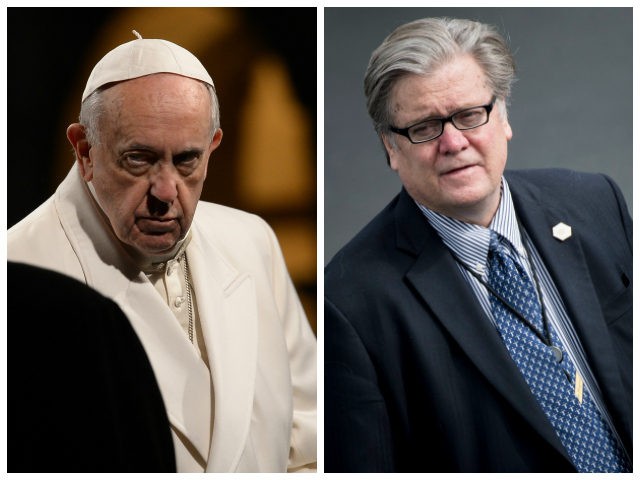The New York Times has added its voice to a chorus of commentators on the recent Vatican hostility toward American Catholics, conservatives, and Steve Bannon in particular.
In an article titled “A Vatican Shot Across the Bow for Hard-Line U.S. Catholics,” Rome correspondent Jason Horowitz analyzes a three-week old essay that appeared July 13 in the Vatican-vetted journal La Civiltà Cattolica alleging a dark “ecumenism of hate” between American evangelicals and conservative Catholics.
Abandoning its age-old practice of avoiding direct attacks on Protestant churches or taking sides in partisan politics, the Vatican journal railed against U.S. Evangelicals while sharply criticizing a series of Republican Presidents for their supposed attempts to make the United States into a theocracy. In doing so, the authors—editor-in-chief Father Antonio Spadaro S.J. and Presbyterian Minister Marcelo Figueroa—wound up criticizing the unique relationship between religion and politics that has reigned in America since its founding.
Horowitz notes that the authors “singled out Stephen K. Bannon, Mr. Trump’s chief strategist, as a ‘supporter of an apocalyptic geopolitics.’” Spadaro, who has never met Mr. Bannon, reportedly told Horowitz that it is important to explore the “apocalyptic narrative which inspires” Mr. Bannon, a bold assertion for which he offered no evidence.
The only indication that Bannon espouses an apocalyptic narrative, Horowitz suggests, is that he has “stymied action against climate change and exploited fears of migrants and Muslims.”
Benjamin Harnwell, a Catholic traditionalist in Rome, said the article’s authors were doing little more than “trolling Steve Bannon,” Horowitz writes. As other authors have pointed out, Father Spadaro has succeeded in obtaining his 15 minutes of fame by attacking U.S. Catholics and Bannon in particular, launching the Jesuit’s virtually unknown ecclesiastical journal momentarily into the international limelight.
The entire reason that the Civiltà Cattolica article has received as much attention as it has—despite its academic sloppiness and numerous factual errors—is that its two authors are both personal friends and counselors of Pope Francis.
While it is not clear that the article received the pope’s direct blessing, Horowitz observes, there “has apparently been no reprimand from the pope, who is not shy about disciplining dissenters, and La Civiltà Cattolica’s editor has promoted the article nearly every day since it was published in July.”
Horowitz also suggests that accusations of a creeping anti-Americanism in the Vatican may not be unfounded. “It is no secret that Francis, the first Latin American pope, who has often criticized capitalism, has a complicated view of his old neighbors to the north,” he wrote.
According to one unnamed Vatican source, early in his pontificate Francis declared of the church in the United States: “That’s where the opposition is coming from.”
The authors of the article “suggest that so-called values voters are using the banners of religious liberty and opposition to abortion to try to supplant secularism with a ‘theocratic type of state,’” Horowitz writes.
In his essay, Father Spadaro warned of the social-religious groups that “consider the United States to be a nation blessed by God,” suggesting that belief in the singularity in the American experiment was unhealthy and could only breed fanaticism. Curiously, not long afterward, Los Angeles Archbishop José Gómez himself tweeted about America’s uniqueness.
The promise of America — what still distinguishes this country from all the rest — is our commitment to promoting human dignity and freedom.
— Abp. José H. Gomez (@ArchbishopGomez) August 2, 2017
For his part, Archbishop Charles J. Chaput of Philadelphia, a “standard-bearer for conservatism in America,” called Spadaro’s article “an exercise in dumbing down and inadequately presenting the nature of Catholic/evangelical cooperation on religious freedom and other key issues,” Horowitz said.
On closer analysis, the actual history of Catholic-evangelical cooperation in the United States bears little resemblance to the description offered by Spadaro and Figueroa.
The most significant common statement of ecumenism between Evangelicals and Catholics was the 1994 manifesto titled “Evangelicals & Catholics Together: The Christian Mission in the Third Millennium” (ECT). Prepared after many months of discussions and signed by leading figures from the Evangelical and Catholic communities, the document marked the acme of Catholic-Evangelical ecumenism that has so irritated Father Spadaro.
Although Spadaro wrote that this ecumenism had taken place between “Evangelical Fundamentalists” and “Catholic integralists,” that was clearly never the case.
Those who self-identify as radical traditionalists reject ecumenism outright and prefer to speak of converting those who still live within the errors of Protestantism rather than “dialoguing” with them. Moreover, they focus far more on liturgical questions than on political or even moral issues.
On the Protestant side, radical fundamentalists do not believe in dialogue with Catholics, since they consider the Catholic Church to be “the whore of Babylon” and question whether Catholics are indeed even Christians.
Those who spearheaded Evangelical-Catholic ecumenism in the United States were indisputably mainstream, albeit clearly orthodox, Catholics.
Among the eminent Catholic signers of ECT were Cardinal Francis George, Cardinal John O’Connor, Jesuit Cardinal Avery Dulles, Cardinal Francis Stafford, Father Richard John Neuhaus, Ambassador Mary Ann Glendon, George Weigel, Archbishop Augustine DiNoia OP, and Jesuit Father Juan Diaz-Vilar of Catholic Hispanic Ministries.
The following year (1995), Saint John Paul II issued his own teaching letter on ecumenism, called Ut Unum Sint, in which he praised just the sort of dialogue advocated by ECT.
Follow Thomas D. Williams on Twitter Follow @tdwilliamsrome

COMMENTS
Please let us know if you're having issues with commenting.